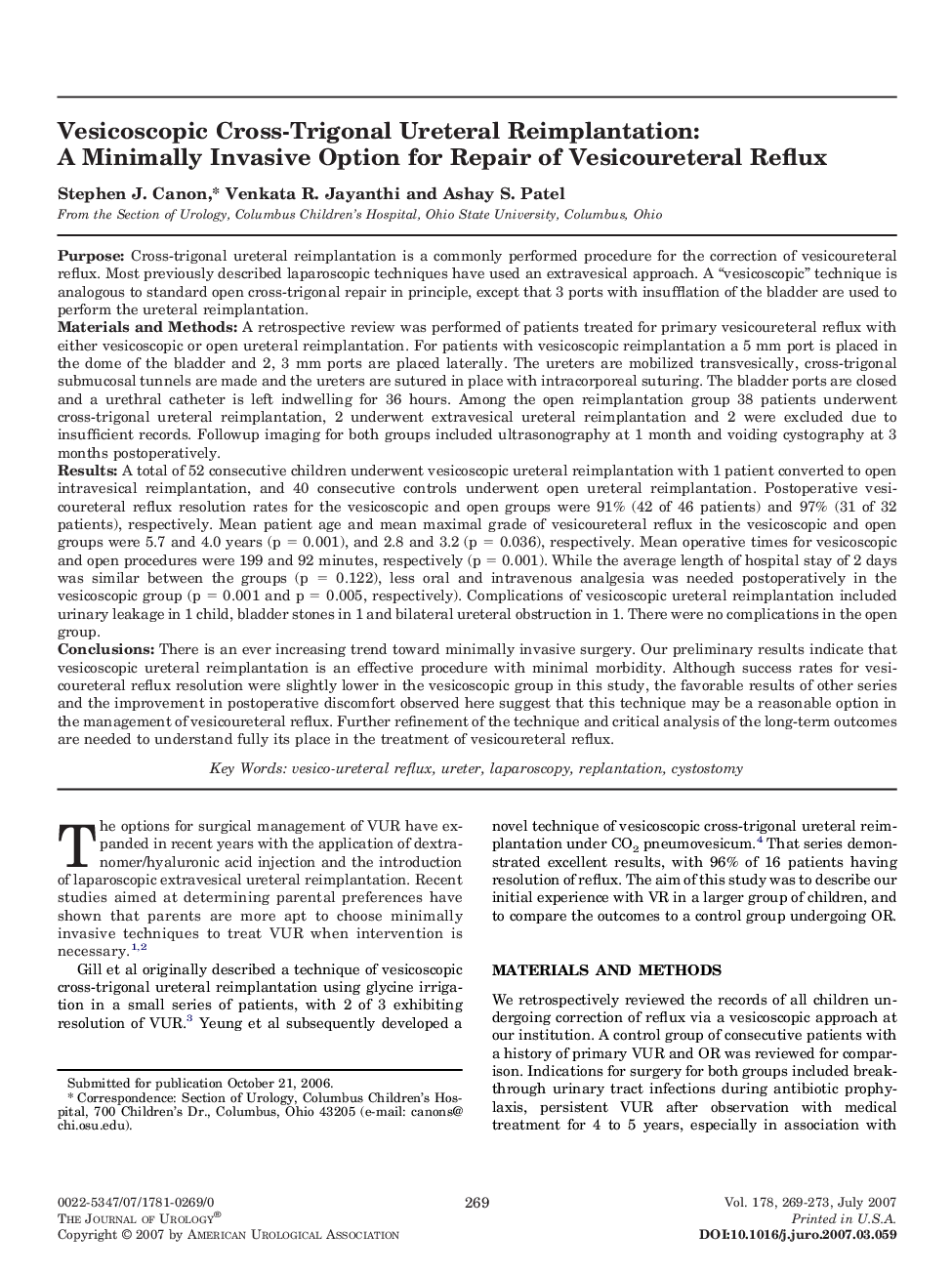| کد مقاله | کد نشریه | سال انتشار | مقاله انگلیسی | نسخه تمام متن |
|---|---|---|---|---|
| 3878558 | 1599007 | 2007 | 5 صفحه PDF | دانلود رایگان |

PurposeCross-trigonal ureteral reimplantation is a commonly performed procedure for the correction of vesicoureteral reflux. Most previously described laparoscopic techniques have used an extravesical approach. A “vesicoscopic” technique is analogous to standard open cross-trigonal repair in principle, except that 3 ports with insufflation of the bladder are used to perform the ureteral reimplantation.Materials and MethodsA retrospective review was performed of patients treated for primary vesicoureteral reflux with either vesicoscopic or open ureteral reimplantation. For patients with vesicoscopic reimplantation a 5 mm port is placed in the dome of the bladder and 2, 3 mm ports are placed laterally. The ureters are mobilized transvesically, cross-trigonal submucosal tunnels are made and the ureters are sutured in place with intracorporeal suturing. The bladder ports are closed and a urethral catheter is left indwelling for 36 hours. Among the open reimplantation group 38 patients underwent cross-trigonal ureteral reimplantation, 2 underwent extravesical ureteral reimplantation and 2 were excluded due to insufficient records. Followup imaging for both groups included ultrasonography at 1 month and voiding cystography at 3 months postoperatively.ResultsA total of 52 consecutive children underwent vesicoscopic ureteral reimplantation with 1 patient converted to open intravesical reimplantation, and 40 consecutive controls underwent open ureteral reimplantation. Postoperative vesicoureteral reflux resolution rates for the vesicoscopic and open groups were 91% (42 of 46 patients) and 97% (31 of 32 patients), respectively. Mean patient age and mean maximal grade of vesicoureteral reflux in the vesicoscopic and open groups were 5.7 and 4.0 years (p = 0.001), and 2.8 and 3.2 (p = 0.036), respectively. Mean operative times for vesicoscopic and open procedures were 199 and 92 minutes, respectively (p = 0.001). While the average length of hospital stay of 2 days was similar between the groups (p = 0.122), less oral and intravenous analgesia was needed postoperatively in the vesicoscopic group (p = 0.001 and p = 0.005, respectively). Complications of vesicoscopic ureteral reimplantation included urinary leakage in 1 child, bladder stones in 1 and bilateral ureteral obstruction in 1. There were no complications in the open group.ConclusionsThere is an ever increasing trend toward minimally invasive surgery. Our preliminary results indicate that vesicoscopic ureteral reimplantation is an effective procedure with minimal morbidity. Although success rates for vesicoureteral reflux resolution were slightly lower in the vesicoscopic group in this study, the favorable results of other series and the improvement in postoperative discomfort observed here suggest that this technique may be a reasonable option in the management of vesicoureteral reflux. Further refinement of the technique and critical analysis of the long-term outcomes are needed to understand fully its place in the treatment of vesicoureteral reflux.
Journal: The Journal of Urology - Volume 178, Issue 1, July 2007, Pages 269–273